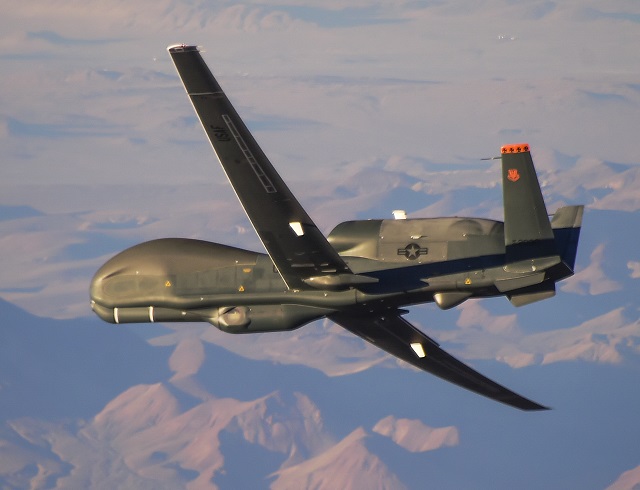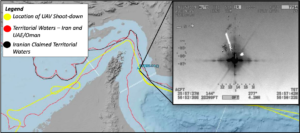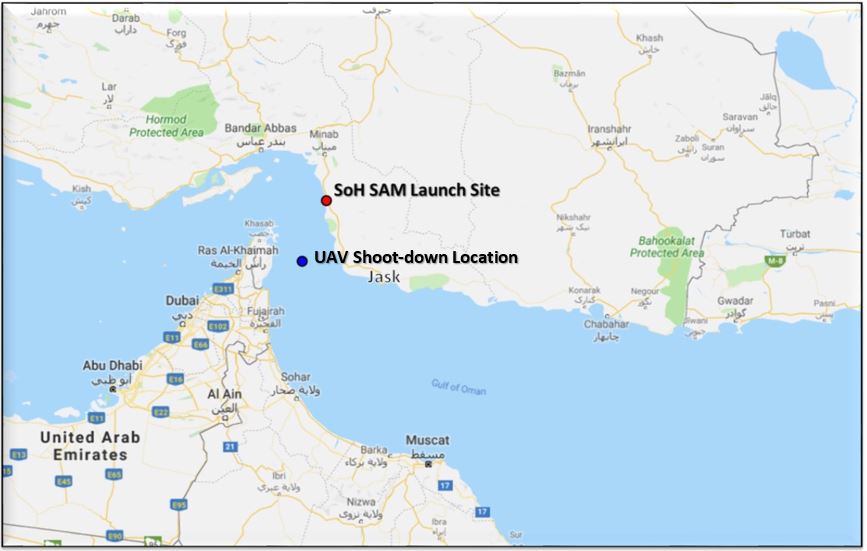By PAUL MCLEARY
 The Global Hawk was downed after two earlier shots at US drones in the region, and attacks on commercial shipping.
The Global Hawk was downed after two earlier shots at US drones in the region, and attacks on commercial shipping.
WASHINGTON: Iranian forces shot down a RQ-4A Global Hawk surveillance drone over the Strait of Hormuz Wednesday night, US officials confirm. This is the latest, and most significant, of a series of attacks in the region that have inflamed tensions between Tehran and Washington.
The drone “was shot down by an Iranian surface-to-air missile system while operating in international airspace,” Navy Capt. Bill Urban, U.S. Central Command spokesman said in a statement today.
Iran’s Islamic Revolutionary Guard Corps said in a statement earlier in the day that the aircraft had entered its airspace and was brought down by its air force near the Kouh-e Mobarak region.

The US military says its drone was shot down outside Iranian airspace.
“Iranian reports that the aircraft was over Iran are false,” Urban said. “This was an unprovoked attack on a U.S. surveillance asset in international airspace.”
The RQ-4 is the Navy’s most advanced high-altitude unmanned aircraft, and is tasked with long-distance missions where it can observe a wide swath of territory, peeking over international borders from well inside international airspace.
Speaking by phone from the Middle East to reporters at the Pentagon Thursday afternoon, Lt. Gen. Joseph Guastella, Commander, U.S. Air Forces Central Command said the drone at no point violated Iranian airspace, and was “operating at high-altitude approximately 34 kilometers from the nearest point of land on the Iranian coast.”

Pentagon-provided map of where the US Global Hawk drone was shot down on Wednesday.
Iran’s Mashregh news agency, which has close ties to the Revolutionary Guard, claimed the drone was shot down by the Khordad missile defense system. Unveiled in 2014 but with an updated version rolled out earlier this month, the air defense system is said be be capable of detecting and tracking targets about 95 miles away, and hitting them around 30 miles away.
Tal Inbar, an Israel military aviation expert, said the Khordad has better capabilities than other Iranian air defense platforms which attempt to copy US Patriot and Russian S-200 systems. “The Iranian systems cannot match western made ones, but their industry is doing huge efforts to improve the products,” he said. “They have the tendency to give the impression that their systems are very advanced, but in most cases this is far from reality.”
The incident comes days after the Pentagon confirmed that Iranian-backed Houthi rebels tried to shoot down a US MQ-4 Reaper drone, and Iranian forces also fired a surface-to-air missile at another Reaper, without success.
The June 6 downing was the result of the Houthis firing a Russian-made SA-6 ground-to-air missile which “indicated an improvement over previous Houthi capability,” according to CENTCOM.
The June 13 miss was a modified Iranian SA-7 missile. It is unclear what missile was used in Wednesday’s attack, but one thing is certain: the missile Iran probably fired certainly cost much less than the $130 million Global Hawk.
No comments:
Post a Comment